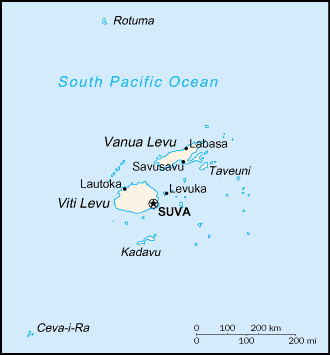Across Fiji
Across Pacific & Asia
Across Pacific & Asia
Background:
 Fiji became independent in 1970, after nearly a century as a British colony. Democratic rule was interrupted by two military coups in 1987, caused by concern over a government perceived as dominated by the Indian community (descendants of contract laborers brought to the islands by the British in the 19th century). A 1990 constitution favored native Melanesian control of Fiji, but led to heavy Indian emigration; the population loss resulted in economic difficulties, but ensured that Melanesians became the majority. Amendments enacted in 1997 made the constitution more equitable. Free and peaceful elections in 1999 resulted in a government led by an Indo-Fijian, but a coup in May 2000 ushered in a prolonged period of political turmoil. Parliamentary elections held in August 2001 provided Fiji with a democratically elected government and gave a mandate to the government of Prime Minister Laisenia QARASE. Location:
Oceania, island group in the South Pacific Ocean, about two-thirds of the way from Hawaii to New Zealand
Population:
893,354 (July 2005 est.)
Economy
- overview:
Fiji, endowed with forest, mineral, and fish resources, is one of the most developed of the Pacific island economies, though still with a large subsistence sector. Sugar exports and a growing tourist industry - with 300,000 to 400,000 tourists annually - are the major sources of foreign exchange. Fiji's sugar has special access to European Union markets, but will be harmed by the EU's decision to cut sugar subsidies. Sugar processing makes up one-third of industrial activity, but is not efficient. Long-term problems include low investment, uncertain land ownership rights, and the government's ability to manage its budget. Yet short-run economic prospects are good, provided tensions do not again erupt between indigenous Fijians and Indo-Fijians. Overseas remittances from Fijians working in Kuwait and Iraq have increased significantly. Import - partners:
Australia 25.9%, Singapore 23.1%, New Zealand 21.1% (2004)
|
| .......................................................................... |
.. |
...........................
.............................................................. .................
|
| ........ |
..............................Building Bridges ACROSS the Barriers.................................... .............................................................................. |
........ |



